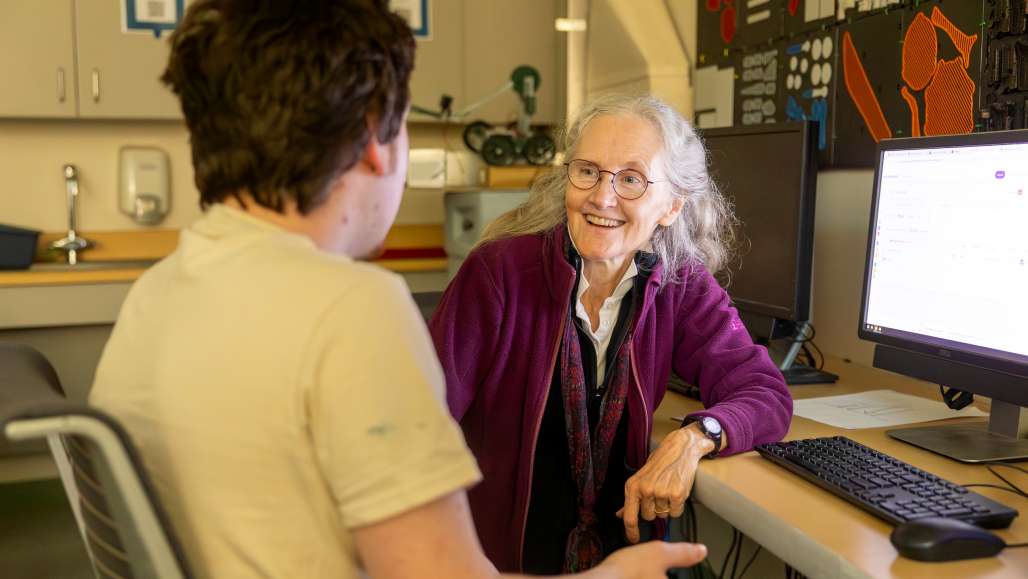Building Lasting Change Through Sustainable Product Design

How do we make things that last?
How can we keep this local?
How can we keep these skills in our community?
For two decades, these questions have guided Dr. Lisa Hix, associate professor and co-chair of the Sustainable Product Design and Innovation (SPDI) program at Keene State College.
And now, her example is for others to follow.
A leader, educator, and innovator, Dr. Hix retired in December.
She leaves a flourishing SPDI program with a track record for preparing students to hit the real world job-ready and where market needs are high. Her imprint is all over the stages of success that mark the popular program; more than 70 students are declared SPDI majors starting the fall semester of 2025.
Hix and fellow faculty members have stayed current with the latest policies and research, guiding students to do the same. This includes integrating global frameworks such as the United Nation’s Sustainable Development Goals, which serve as a guiding tool in the program.
According to Hix, responsible consumption, sustainable industry, and innovation connect directly to product design and manufacturing.
The SPDI curriculum, she notes, reflects the principles of the EU’s Circular Economy Action Plan and the European Green Deal, which focus on climate neutrality, resource efficiency, and waste reduction. Using these tools, faculty encourage students to think creatively and push beyond minimum standards to design solutions that reflect best practices and work in the furtherance of advancing sustainability.
“We’ve built a curriculum and the facilities to deliver the program well,” she says. “I feel proud of that.”
She enjoys the success stories, when graduates return for a visit or send an email, to talk about their impactful work.
“Our alumni are amazingly thoughtful people. They are engaged with their communities. They’re doing interesting things, and they’re contributing in lots of different ways. It’s really about people … so that makes me feel good.”
A college course in ecology sparked her interest in viewing the world through a systems lens—or considering the interconnectedness of things. While focusing on industrial design, she dove deeply into user-centered design, and functional product design, two foundations for creating sustainable products.
“We need to identify the real needs of people, communities, and the natural world so we can support one another and thrive,” she explains. Her post-graduation goal to design the next space station for NASA didn’t materialize.
But “I found the next best thing designing sailing yachts.”
The processes behind these self-contained vehicles delivered a range of experience in her field from prototyping to project management.
She also worked with lighting fixture manufacturers and became a design consultant, which inspired her to earn a master’s in business administration. Her graduate classes were often held at satellite campuses around the state, including at Keene State, where she met Dr. Delmar “Del” Ogg, a Technology, Design, and Safety professor from 1971 to 2006.
Ogg’s work significantly influenced the SPDI program that Hix went on to trailblaze.
She says of her initial discussion with him: “I was intrigued by the opportunity to teach what I love and the potential of manufacturing labs.” It was intriguing enough for her to launch a second career, focused on higher education.
It didn’t take long for Hix to discover she enjoyed working with students. She was inspired by colleagues becoming increasingly interested in the true meaning behind sustainability. One, she says, was Rick Foley.
Characteristically, she dove in, pursuing a doctoral studies degree through the Cleaner Production and Pollution Prevention program at the University of Massachusetts.
“Part of my dissertation became: How do we create a curriculum around new product design and sustainability?”
As the curriculum for the SPDI program was envisioned, so was a cutting-edge facility to support it. The resulting manufacturing labs at Keene were brought to fruition with remarkable intention.
“For instance, our CAD design area—our Ideation Lab, as we call it—is next to the manufacturing labs so students can flow back and forth. We’re not separating the design from the manufacturing. This is integral so the products can be well-designed, durable, and lasting—and so that we can keep experimenting.”
This real-world, hands-on approach can be seen woven throughout the SPDI experience, showcased in Hix’s illustrated material lifecycle project, an educational tool she developed to help students visually understand the full life cycle of materials and products, including the impacts on workers and human health.
“What’s often forgotten is the worker, the person making the materials, fixing the products, installing, repairing,” she says. “There can be toxic exposure, injury, or even things that just don’t work well. So how do we ensure we’re paying attention to the people?”
We’ll end there, where we begin, with one of our college’s dedicated, forward-thinking educators posing another meaningful, probing question. Dr. Hix will be greatly missed by students, colleagues, and grateful Keene State friends alike.

